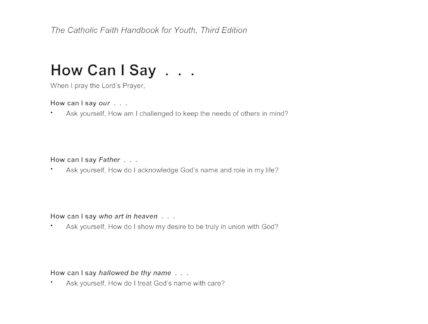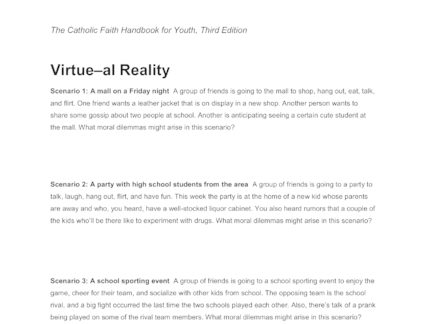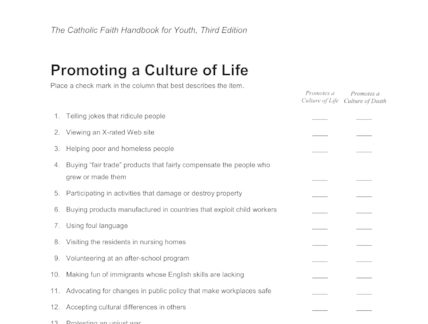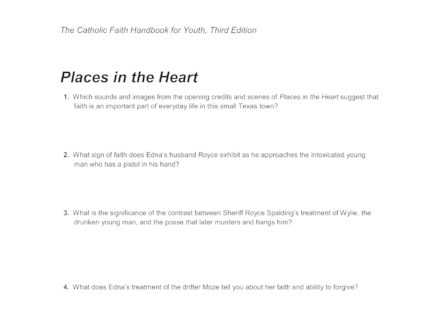Worksheets
47 results
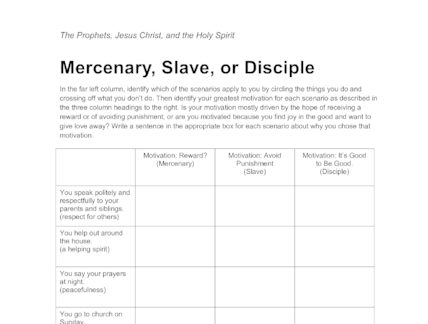
Document
Mercenary, Slave, or Disciple
Students identify their motivation for doing good deeds before reflecting on the role of grace in their lives.
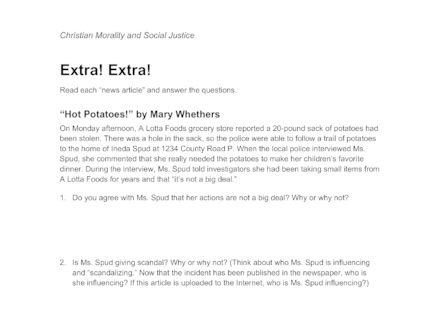
Document
Extra! Extra!
Students read two “news articles” and evaluate the morality of each by answering a series of questions.
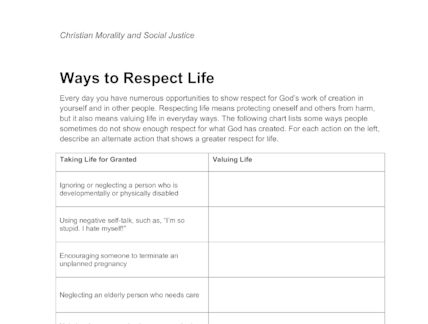
Document
Ways to Respect Life
This worksheet challenges students to think about how they can value the dignity of life on a day-to-day basis.
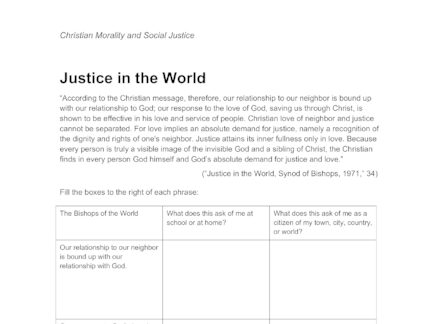
Document
Justice in the World
This worksheet challenges students to think about how the teachings about Justice from the Bishops of the World apply to their daily lives.
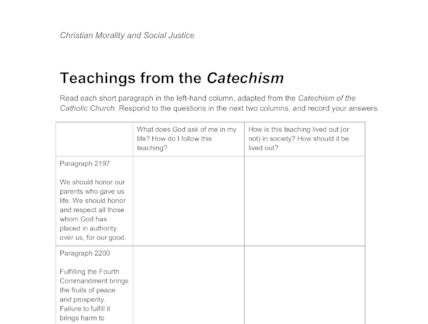
Document
Teachings from the Catechism
This worksheet challenges students to think about how the teachings from the Catechism on the fourth commandment apply to their daily lives.
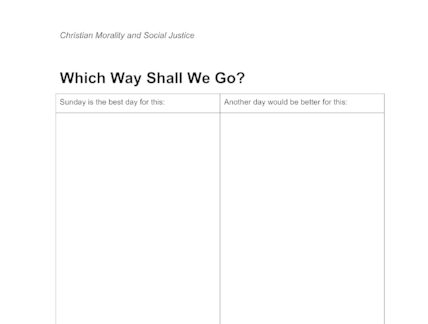
Document
Which Way Shall We Go?
This handout provides a chart for students to list activities that are best to do on Sunday and those that should be saved for other days of the week.
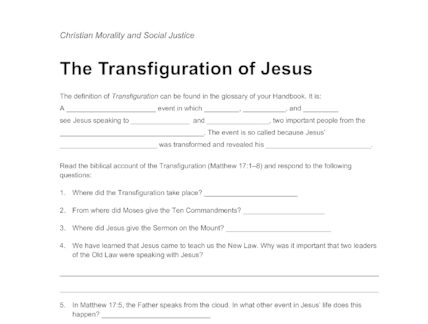
Document
The Transfiguration of Jesus
This worksheet helps students to read Scripture passages, answer questions about, and understand the importance of the Transfiguration of Jesus.
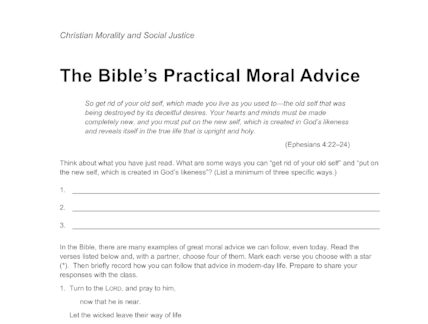
Document
The Bible’s Practical Moral Advice
This worksheet guides students as they look up Scripture passages that give moral advice.
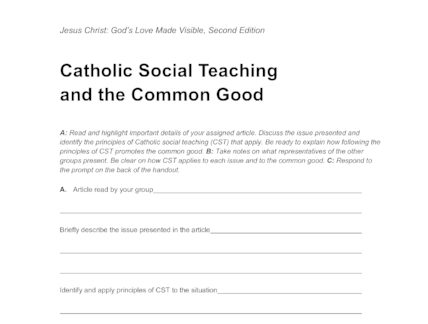
Document
Catholic Social Teaching and the Common Good
This worksheet helps students to take notes as they read articles and make connections to the principles of Catholic Social Teaching.
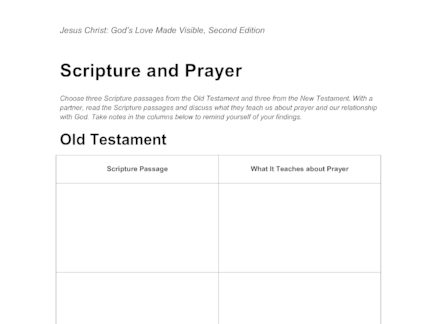
Document
Scripture and Prayer
On this worksheet partners choose three scripture passages from both the Old and New Testaments. They then note how what each passage teaches about prayer and our relationship with God.

Document
When To Keep Things Confidential
After reading several pieces of information that might be shared by a friend, students decide which should be kept confidential and which might be shared with others.
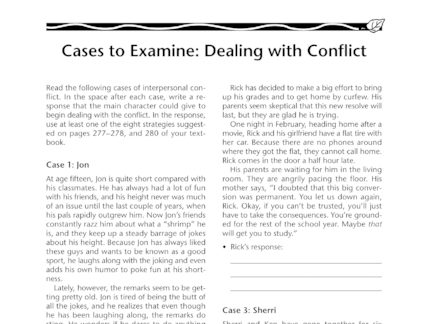
Document
Cases to Examine: Dealing with Conflict
This handout provides three situations for students to read and evaluate. Students must give a suggestion for how to respond to the conflict in each scenario based on the strategies in the book.

Document
What is the State of Justice?
Evaluate the degree to which the seven themes of Catholic social teaching are present in a given situation. Use the scale below each theme to rank the extent to which it is present or absent, and write N/A (not applicable) …
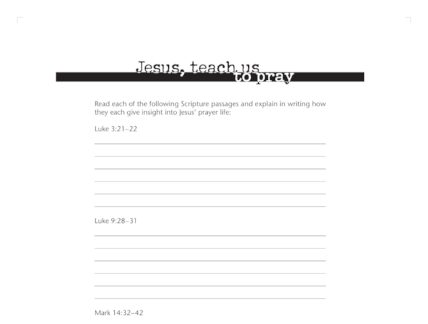
Document
Jesus, Teach Us to Pray
Read each of the following Scripture passages and explain in writing how they each give insight into Jesus’ prayer life.
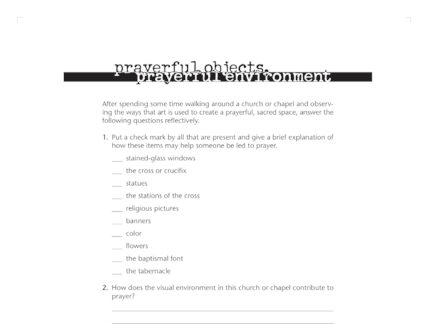
Document
Prayer Objects, Prayerful Environment
After spending some time walking around a church or chapel and observing the ways that art is used to create a prayerful, sacred space, answer the following questions reflectively.

Document
Karma Marga: "The Path of Works"
For each of the following actions, write a selfish motivation and a selfless motivation. Responses have been supplied for the first action as examples.
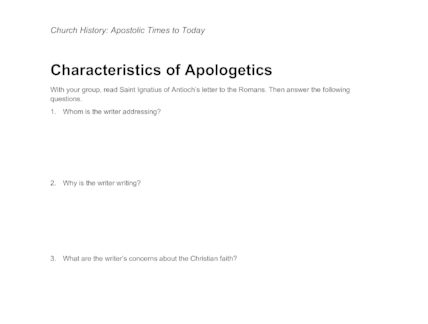
Document
Characteristics of Apologetics
With your group, read Saint Ignatius of Antioch’s letter to the Romans. Then answer the following questions.
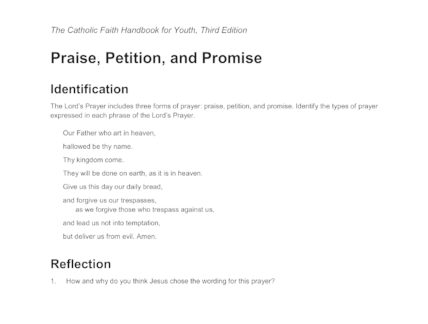
Document
Handout: Praise Petition and Promise
The Lord’s Prayer includes three forms of prayer: praise, petition, and promise. Identify the types of prayer expressed in each phrase of the Lord’s Prayer.
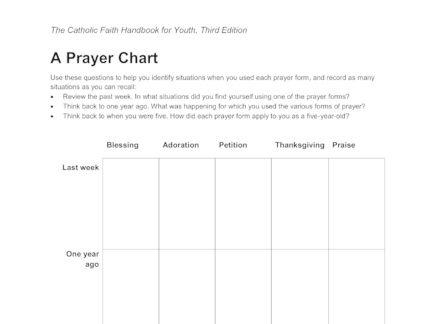
Document
Handout: A Prayer Chart
Use these questions to help you identify situations when you used each prayer form, and record as many situations as you can recall.
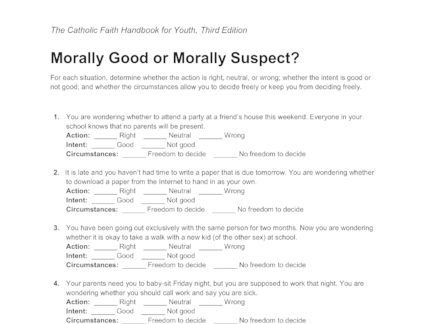
Document
Handout: Morally Good or Morally Suspect
For each situation, determine whether the action is right, neutral, or wrong; whether the intent is good or not good; and whether the circumstances allow you to decide freely or keep you from deciding freely.
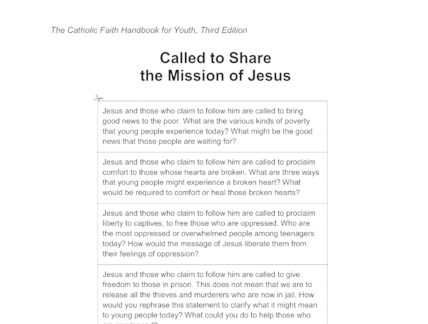
Document
Called to Share the Mission of Jesus
Questions about how we can imitate Jesus’ example in the way we interact with others.

Document
Living in a Material World
Consider the following list of things. Which of them is necessary for you to have in order to be happy? Place a check mark in front of each one you feel is necessary.
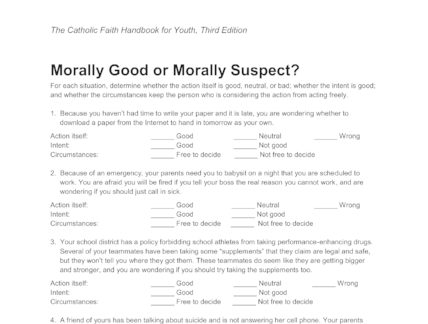
Document
Morally Good or Morally Suspect
For each situation, determine whether the action itself is good, neutral, or bad; whether the intent is good; and whether the circumstances keep the person who is considering the action from acting freely.

Document
A Living Sign of Hope
We believe that because we are transformed by faith in the Risen Jesus, his presence in the world becomes more visible through us. Read the following statements that are based on Jesus’ teachings, and then answer the questions that follow. …
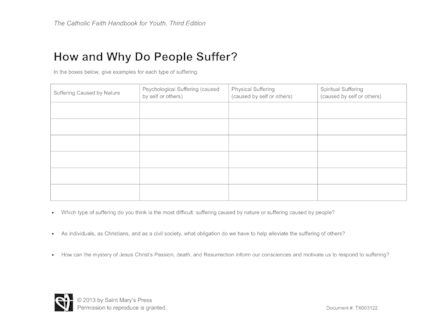
Document
How and Why Do People Suffer?
In the boxes below, give examples for each type of suffering, and respond to the questions that follow.
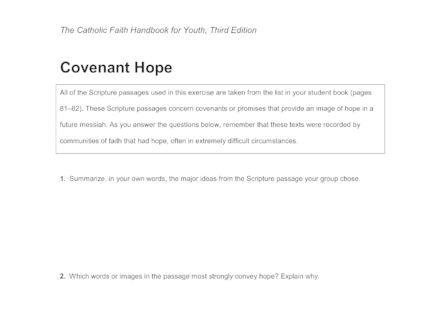
Document
Covenant Hope
All of the Scripture passages used in this exercise are taken from the list in your student book (pages 81–82). These Scripture passages concern covenants or promises that provide an image of hope in a future messiah. As you answer …
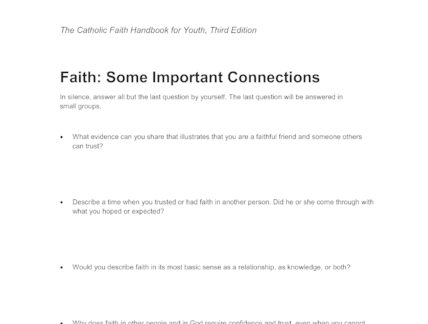
Document
Faith: Some Important Connections
In silence, answer all but the last question by yourself. The last question will be answered in small groups.
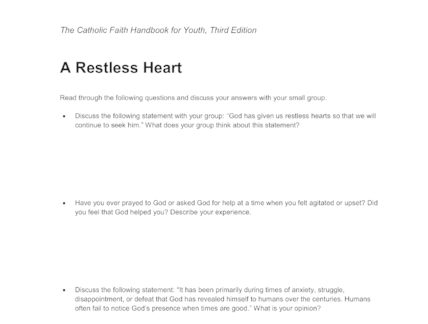
Document
A Restless Heart
Read through the following questions and discuss your answers with your small group.

Document
Core Beliefs Practices and Attitudes of the Catholic Faith
Each statement below is a core belief of the Catholic faith. Choose a symbol (“I get it,” “I’m unsure,” or “I don’t get it”) that best reflects your understanding of each belief. Then briefly explain what you might know about …
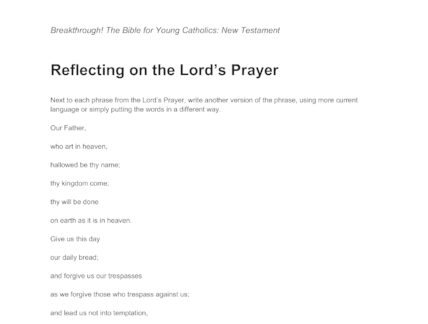
Document
Reflecting on the Lord's Prayer
Next to each phrase from the Lord’s Prayer, write another version of the phrase, using more current language or simply putting the words in a different way.
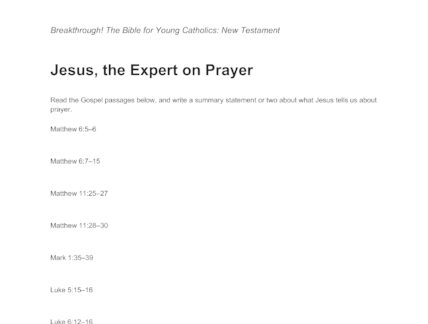
Document
Jesus, the Expert on Prayer
Read the Gospel passages below, and write a summary statement or two about what Jesus tells us about prayer.
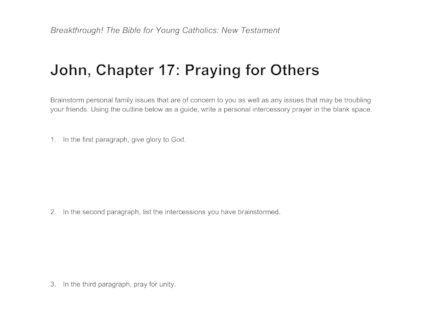
Document
John, Chapter 17: Praying for Others
Brainstorm personal family issues that are of concern to you as well as any issues that may be troubling your friends. Using the outline below as a guide, write a personal intercessory prayer in the blank space.
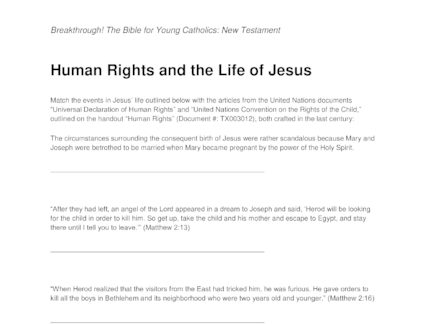
Document
Human Rights and the Life of Jesus
Match the events in Jesus’ life outlined below with the articles from the United Nations documents “Universal Declaration of Human Rights” and “United Nations Convention on the Rights of the Child,” outlined on the handout “Human Rights” (Document #: TX003012), …

Document
Dilemma Decisions
A worksheet with tough decisions students may be faced with in their lives.
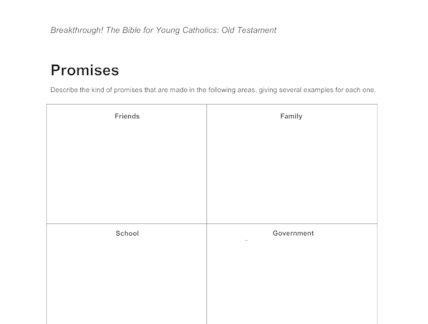
Document
Promises
Describe the kind of promises that are made in the following areas, giving several examples for each one.

Document
Getting to Know God
A worksheet for students to list the places they go to pray to God, listen to God, talk to God, and wait for God.
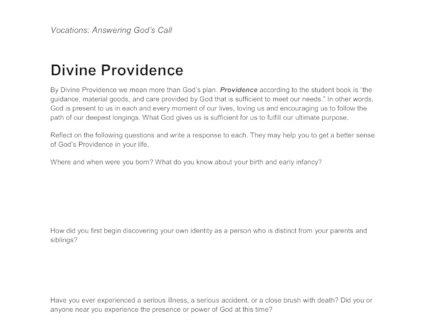
Document
Divine Providence
A reflection worksheet to help students get a better sense of God’s Providence in their lives.
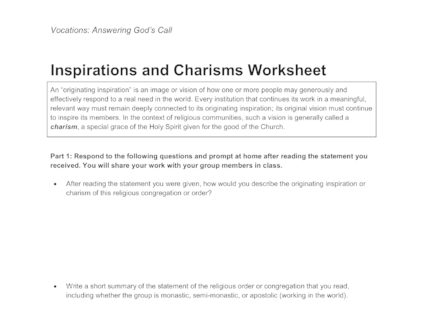
Document
Inspirations and Charisms Worksheet
A partially independent and partially group completed worksheet for students to fill out about the inspirations and charisms of a particular religious congregation or order.

Document
What Will God Call Me to Do
A reflection worksheet and class discussion on the video Gang Busters: One Man’s Mission to Stop Bullets by Creating Jobs.
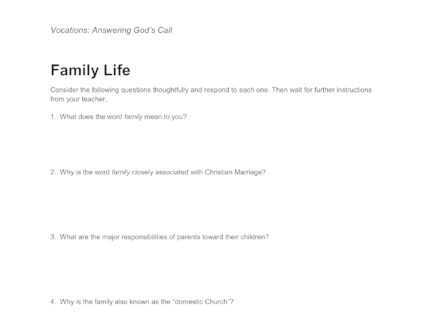
Document
Family Life
A worksheet with questions about the meaning of the family, the responsibilities of parents, the domestic Church, as well as the influence parents have on their children in their moral and spiritual development.
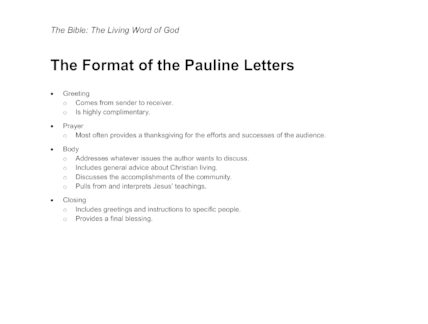
Document
The Format of the Pauline Letters
This handout is part of the Living in Christ Series. It outlines the format of Paul's letters in the New Testament.


